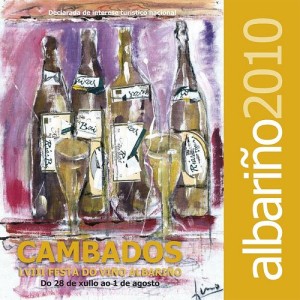
Albariño 2010 Wine Feast
The leafy Paseo de la Calzada in Cambados is the setting for one of Spain’s longest running gastronomic fairs. About to celebrate its 58th year, the Fiesta de Albariño draws huge crowds of up to 300,000 people, from presidents and their entourages, to glitterati from the world of television, film and literature. Things get underway with the ceremony of investiture of the new knights and dames of the Capitulo Serenisimo do Viño Albariño, the Most Serene Order of Albariño Wine.
The inductees take part in a solemn procession, receiving their distinctions from the Grand Master of the Order, Don Manuel Fraga Iribarne, and the coveted bronze, silver and gold medals for best wine of the year are awarded at the ‘Xantar dos Cabaleiros’, a grand knights ‘banquet held in the gardens of the beautiful Pazo Torrado. The fiesta itself, a hedonistic affair, rages well into the early hours, with jovial ‘peñas’, or revellers dressed in their distinctive t-shirts, loud-hailers in hand, rally their troops along the Paseo de la Calzada. A walk through the Paseo will reveal stand after stand of producers selling Albariño by the glass or bottle. Other stands sell local delicacies such as Empanada de Xoubas or sardine pie, Queso Tetilla, local cheese famously or infamously shaped like a female breast. The most popular stall by far is the one serving Pulpo á Feira, or octopus to the party, as it’s sometimes amusingly translated. The pulpeira or octopus lady deftly snips pieces of the tentacled beast onto a wooden plate, on goes the coarse sea salt, a dusting of pimentón picante or hot paprika and a quick drizzle of olive oil and that’s it. Devastatingly simple.
On Rua Sabugueiro you’ll find the charming Pazo de la Capitana, built by a family who served in the Spanish colonial government in Cuba. An imposing gateway leads through to a beautiful stone courtyard with a fountain, overhead vines, centuries old boxwood trees and an immense granite horreo or rat-proof granary. The Argentinian manager Pilar proudly informed us that there’s mounting genetic evidence that proves beyond reasonable doubt that the Albariño grape is an species native to Galicia and not brought from the Rhineland by Cluniac monks in the middle ages as was originally thought. The guest rooms here are truly lovely and their excellent Albariño is bottled and cased on site. For the real jewel of Cambados one must head for the wonderfully aristocratic Pazo de Fefiñanes. This awe inspiring building dating from the 17th century also doubles as a winery where you can taste (by appointment) the excellent Pazo de Fefiñanes Albariño and other wine related products such as licor café, aguardiente de hierbas and aguardiente tostado. Aguardiente is the potent liquor distilled from the skins of the grapes after pressing.
The whole square and its adjacent buildings at one time belonged to just one individual, Don Juan Sarmiento Valladares, advisor to Phillip II. The town was originally divided into three separate areas, the aristocratic Villa de Fefiñanes, the Villa de Cambados, where the petty nobility lived, and the Villa de Santo Tomé, humble abode of the town’s fishermen and their families. The former aristocratic villa today is given over to a myriad of bars, cafés and restaurants offering traditional Galician tapeo and several Cambados institutions that specialise in seafood harvested from the Ria de Arousa. The competition between them is stiff, so the quality is exceptionally high. Some marisquerias or seafood restaurants to look out for are A Posta do Sol, Ribadomar and Dos Islas. Rua Hospital is probably one of the most picturesque streets in town. Lined with beautiful granite houses with stone staircases leading up to cute green doors and pretty flower boxes, it’s wonderful place to take a stroll after lunch. The Continental Café below the michelin star rated restaurant Yayo Daporta is the perfect spot to unwind with a café con hielo or iced coffee after lunch.
This is the place to get your bearings as it will be the place you’ll probably end up in around midnight. The streets that run parallel to Rua Hospital is the zona de marcha, or place to go pubbing after dinner. Pubs will start to fill up around 12.30 onwards, so just take your pick if you still have energy after a hard day on the Albariño and one of Spain finest celebrations of food and drink.






